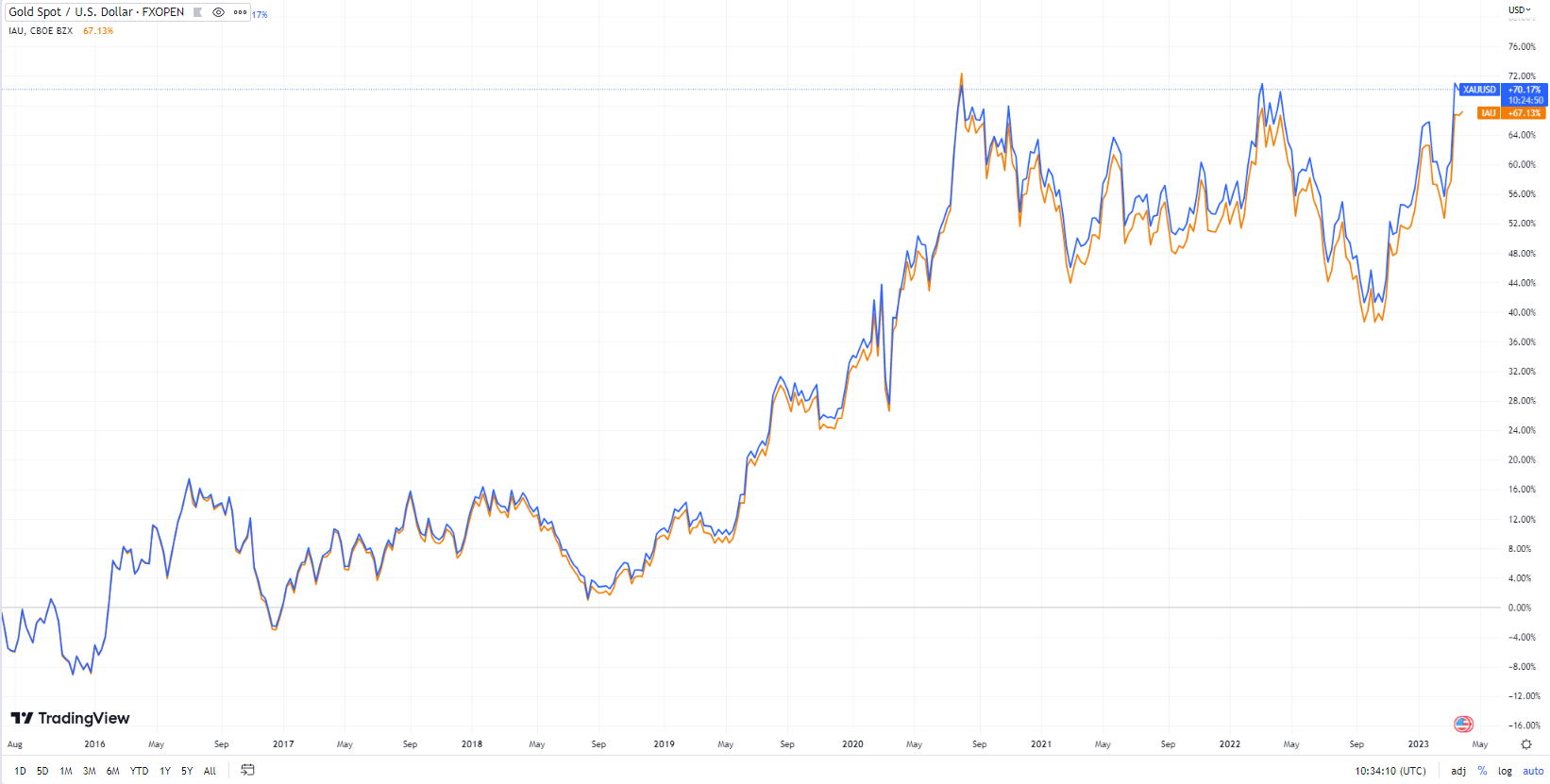Are Gold And Cash-Like ETFs The Best Investment Strategy Now?

Table of Contents
The current economic uncertainty, marked by inflation, geopolitical risks, and the looming threat of recession, has many investors scrambling to protect their portfolios. A popular strategy involves seeking refuge in safe haven assets. This article examines whether investing in gold and cash-like ETFs is the optimal approach in today's turbulent market. We'll delve into the advantages and disadvantages of this strategy, helping you determine if it aligns with your financial goals.
Understanding Gold ETFs as a Safe Haven Investment
The Role of Gold in Diversification
Gold has long been considered a safe haven asset, offering several key benefits within a diversified portfolio:
- Protection against inflation: Historically, gold's value tends to rise during periods of high inflation, acting as a hedge against the erosion of purchasing power.
- Negative correlation with stocks: Gold often performs inversely to stocks, meaning it can provide a cushion during stock market downturns. This negative correlation is crucial for diversification.
- Historical performance during economic downturns: Data shows gold frequently outperforms other asset classes during recessions and economic crises. For example, during the 2008 financial crisis, gold prices surged significantly.
- Safe haven asset during geopolitical instability: Geopolitical uncertainty and global crises often drive investors towards the perceived safety and stability of gold.
Diversification is a cornerstone of sound investment strategy. By allocating a portion of your portfolio to gold ETFs, you can reduce overall portfolio volatility and mitigate the impact of market fluctuations. A well-diversified portfolio reduces risk by spreading investments across different asset classes with varying degrees of correlation.
Choosing the Right Gold ETF
Selecting the appropriate gold ETF requires careful consideration of several factors:
- Expense ratio: Choose ETFs with low expense ratios to maximize your returns.
- Holdings: Ensure the ETF holds physical gold, and understand its storage and security arrangements.
- Trading volume: High trading volume ensures liquidity and ease of buying and selling.
- Physical backing: Physically-backed gold ETFs hold actual gold reserves, offering greater transparency and security compared to unbacked ETFs.
Popular gold ETFs include GLD (SPDR Gold Shares) and IAU (iShares Gold Trust). However, it's essential to research and compare various ETFs before making an investment decision. Remember that even gold ETFs carry some risk, including price volatility and counterparty risk (the risk that the issuer of the ETF might default).
Cash-Like ETFs: Liquidity and Stability
The Benefits of Cash-Like ETFs
Cash-like ETFs provide investors with a stable and easily accessible investment option. Their benefits include:
- High liquidity: They are easy to buy and sell, allowing for quick access to your funds.
- Low risk: These ETFs generally carry a low level of risk, making them suitable for risk-averse investors.
- Preservation of capital: Their primary aim is to preserve capital rather than generate high returns.
- Ease of access: Trading is typically straightforward and efficient.
- Potential for short-term gains: While not high-growth investments, they can offer modest returns over the short term.
Examples of cash-like ETFs include money market funds and short-term bond ETFs. Money market funds typically invest in highly liquid, short-term debt securities, while short-term bond ETFs focus on bonds with maturities of one year or less.
Cash-Like ETFs vs. Traditional Savings Accounts
Cash-like ETFs offer several advantages over traditional savings accounts:
- Higher yields: They often provide better returns than standard savings accounts.
- Lower fees: Some ETFs have lower fees than traditional accounts.
- Greater accessibility: They offer more convenient access through online brokerage platforms.
- No FDIC Insurance: Unlike savings accounts insured by the FDIC, ETFs lack this type of government backing.
Assessing the Current Market Conditions
Inflation's Impact on Gold and Cash-Like ETFs
Inflation erodes the purchasing power of cash. Gold, however, often acts as an inflation hedge, as its value tends to rise with inflation. Rising interest rates, often a response to inflation, can influence the attractiveness of both gold and cash-like ETFs. Higher rates can reduce the appeal of cash-like ETFs by offering better returns elsewhere.
Geopolitical Risks and Their Influence
Geopolitical instability frequently boosts demand for gold, as investors seek safe havens. Conversely, significant global events can impact the stability of cash-like investments, though generally less so than other asset classes.
Interest Rate Hikes and Their Effect on Investment Strategy
Rising interest rates can impact investment strategies. While higher rates could potentially increase returns on cash-like ETFs, they might make gold less attractive compared to interest-bearing assets. The overall impact depends on the magnitude and duration of the interest rate hikes.
Building a Balanced Portfolio
Asset Allocation Strategies
Integrating gold and cash-like ETFs into a diversified portfolio is key. A common approach is the 60/40 portfolio (60% stocks, 40% bonds), which could incorporate a small allocation to gold and cash-like ETFs to enhance risk mitigation. The exact allocation should depend on your investment goals and risk tolerance.
Considering Your Risk Tolerance
Before investing in gold and cash-like ETFs, assess your risk tolerance. Gold provides a level of stability, while cash-like ETFs offer liquidity and low risk. Your personal risk profile will determine the ideal proportion of these assets within your overall investment strategy.
Conclusion
Gold and cash-like ETFs can be valuable tools for diversifying your portfolio and mitigating risk in uncertain economic times. They offer different benefits: gold as an inflation hedge and safe haven, and cash-like ETFs for liquidity and stability. However, it’s crucial to understand their limitations and potential risks.
While gold and cash-like ETFs can offer valuable benefits, carefully consider your investment goals and risk tolerance before making any decisions. Conduct thorough research and possibly consult with a financial advisor to determine if a strategy incorporating gold and cash-like ETFs is right for your portfolio. Learn more about optimizing your investment strategy with gold and cash-like ETFs today!

Featured Posts
-
 Culture Bourse Pourquoi Solutions 30 Est En Hausse
Apr 23, 2025
Culture Bourse Pourquoi Solutions 30 Est En Hausse
Apr 23, 2025 -
 Canadian Households Face Posthaste Economic Hardship Due To Trump Tariffs
Apr 23, 2025
Canadian Households Face Posthaste Economic Hardship Due To Trump Tariffs
Apr 23, 2025 -
 Remembering Bob Uecker Cory Provuss Heartfelt Tribute
Apr 23, 2025
Remembering Bob Uecker Cory Provuss Heartfelt Tribute
Apr 23, 2025 -
 Brewers Defeat Reds Despite Cincinnatis Offensive Breakthrough
Apr 23, 2025
Brewers Defeat Reds Despite Cincinnatis Offensive Breakthrough
Apr 23, 2025 -
 Amandine Gerard Je T Aime Moi Non Plus Analyse Des Relations Europe Marches
Apr 23, 2025
Amandine Gerard Je T Aime Moi Non Plus Analyse Des Relations Europe Marches
Apr 23, 2025
